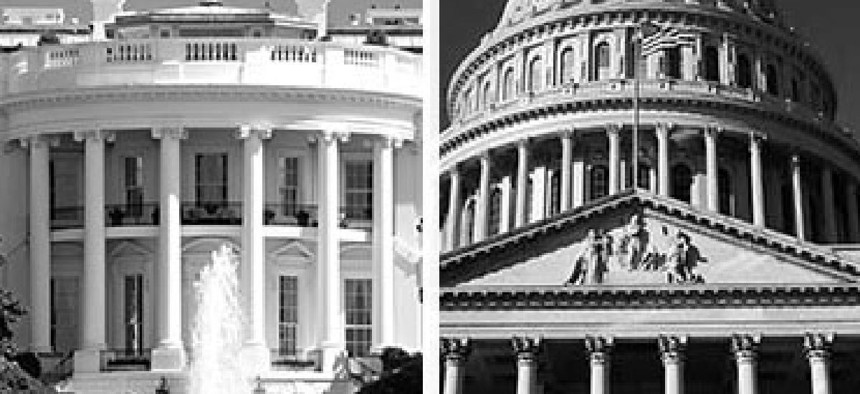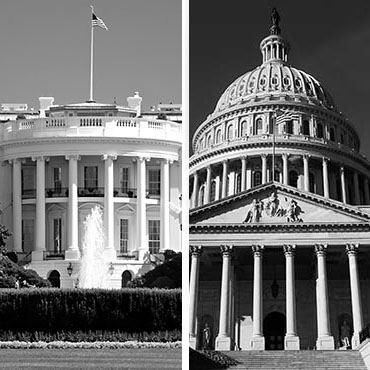Shutdown guide, CTO study, US/UK cyber ties and more

News and notes from around the federal IT community.

Who keeps working during a shutdown?
The Office of Management and Budget issued shutdown contingency plans for most federal agencies on Sept. 25. The move came as House Speaker John Boehner's resignation sparked speculation that a shutdown would be averted.
But if Congress stays at an impasse, the purse strings will tighten, and the contingency plans outline the impact.
Much of the data produced by Commerce Department agencies, upon which many businesses rely, would be off-line. Data from the Census Bureau and Bureau of Economic Analysis would be unavailable, while most research activities at the National Institute of Standards and Technology and the National Oceanic and Atmospheric Administration would also be on hold. Hurricane-tracking and the Federal Aviation Administration's flight-tracking data would remain available.
The General Services Administration would put the buildings under its management in open "weekend mode" and would furlough most employees.
The Office of Personnel Management would keep some 4,500 employees on the job because many of its functions are self-funding, though if other agencies stop paying their fees in a protracted shutdown, some of those employees might eventually be furloughed. OPM's contingency plan notes, "It is theoretically possible that funds from some of these revolving fund activities may not last throughout a lengthy shutdown."
In the Department of Homeland Security, which runs the Transportation Security Administration, Secret Service and Einstein cybersecurity tool, most employees would stay on the job. Nearly 195,000 of the roughly 228,000-strong workforce are considered exempt.
At the White House, 545 employees would be designated exempt; the other 1,263 would report to work for four hours on Oct. 1 before being furloughed. At OMB, 128 employees -- more than one-quarter of the total workforce -- would stay on the job.
See the full list of agency contingency plans here.
PSC begins CTO study
The Professional Services Council has begun a study of the emerging roles and responsibilities of chief technology officers, the trade group said Sept. 28.
The study will include interviews with federal and commercial CTOs and focus on how the position is driving innovation at organizations. Robin Lineberger of Deloitte and Casey Coleman of Unisys will lead the study, which is slated for release in early 2016.
"Since the establishment of agency-level CTOs is a new phenomenon at most agencies, there is wide variance in the responsibilities of the position, where it is organizationally placed and the authorities that the CTO has to effect innovation within the agency," Lineberger said in a statement.
U.S. and U.K. strengthen digital gov ties
The governments of the United States and United Kingdom announced plans to build closer ties between their respective technical teams that set digital policy and offer citizen-facing digital services.
The U.K. has been a leader in digital government and has corralled disparate government services under the umbrella of a single site. Leading officials from the two countries, including Office of Management and Budget Director Shaun Donovan and Minister for the Cabinet Office Matthew Hancock announced the plan at a White House meeting on Sept. 24.
Specific plans for collaboration were not announced, but the U.S. and U.K. intend to share information on best practices and possibly exchange technical personnel.
Uncle Sam's guide to web design
The General Services Administration's 18F unveiled a web design guide, produced with the U.S. Digital Service, on Sept. 28.
The U.S. Web Design Standards guide includes design element code, fonts and a red-white-and-blue-heavy color palette, all aimed at promoting "simplicity and consistency across government services" online.
DOD upgrades Forge.mil
Forge.mil, the Defense Department's collaborative technology development platform, has a new set of tools meant to make the site more interactive.
It now runs CollabNet's TeamForge application management software, and in the coming months, it will add the open-source Git tool and Gerrit, a code review system, the Defense Information Systems Agency announced.
"The integration of Git and Gerrit along with greater metrics-reporting capabilities are features in high demand by the Forge.mil community," said Carey Burris, the Forge.mil project lead, in a statement. "We expect the inclusion of these new tools within the next few months to increase the effectiveness and productivity of current project teams and encourage new project teams to adopt Forge.mil as their tool of choice for software development."
NASA, NSF announce education and research awards
NASA and the National Science Foundation plan to pour more than $100 million into education partnerships worldwide, the agencies announced Sept. 25.
Through its Science Education Cooperative Agreement Notice, NASA has selected 27 organizations, mainly universities and museums, to receive $42 million to support the spread of NASA science education to Americans of all ages. Specific dollar amounts will be negotiated and awards made by the end of the year, according to NASA.
NSF announced 17 awards totaling $69 million through its Partnerships for International Research and Education program. The globe-spanning awards will link international researchers to tackle science and technology problems ranging from environmental issues to the study of education and cognitive development.
Humans beat computers in face-off
It takes a human to best recognize a human, at least in mugshots, according to a new study on facial recognition from the National Institute of Standards and Technology.
In what NIST said could be a first-its-kind "face-off " test, trained forensics examiners from the FBI and law enforcement agencies worldwide were far more accurate in identifying faces in photographs than non-experts and computers.
The new test is "the first strong evidence that facial forensic examiners are better at face recognition than the rest of us," said Jonathon Phillips, a face recognition researcher at NIST.
Participants reviewed pairs of faces on a computer screen and judged whether they belonged to the same person. Researchers also included inverted images and photos with backgrounds to augment the standard of closely cropped head shots. The faces were chosen because they were hard to recognize and difficult for computer algorithms to distinguish between.
When scores were averaged across all examiners, NIST said the experts achieved a mark of 0.997.
Pentagon awards contract for tracking down OPM breach victims
The Defense Department has taken another step in its quest to notify victims of the Office of Personnel Management data breach by awarding a $1.8 million contract to tech firm Advanced Onion, Nextgov reported.
Under the contract, the company will be responsible for tracking down victims of the breach whose notification letters were returned as undeliverable. According to a justification for the award posted by Nextgov, "Trained analysts will manually process forms by scanning the quick response code on each mailing in order to record the reason for return."
Advanced Onion's second task will be to build a website through the Defense Manpower Data Center that securely logs user information so users can check to see if they were affected by the breach.
NEXT STORY: Pentagon Hires Investigators to Find Hacked Feds


